Welcome back my nature lovers!! This post will start with a short quiz. Can you guess what we'll be discussing today?
A) A cell cluster?
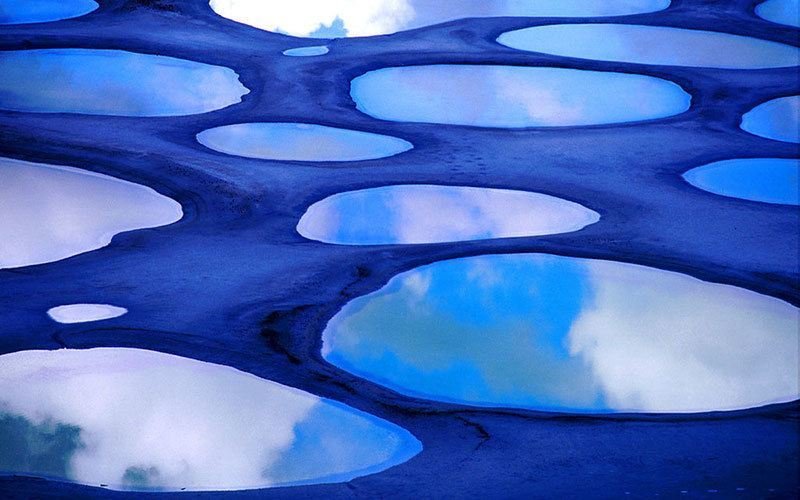
(Image source: all-that-is-interesting.com)
B) A huge bee hive?
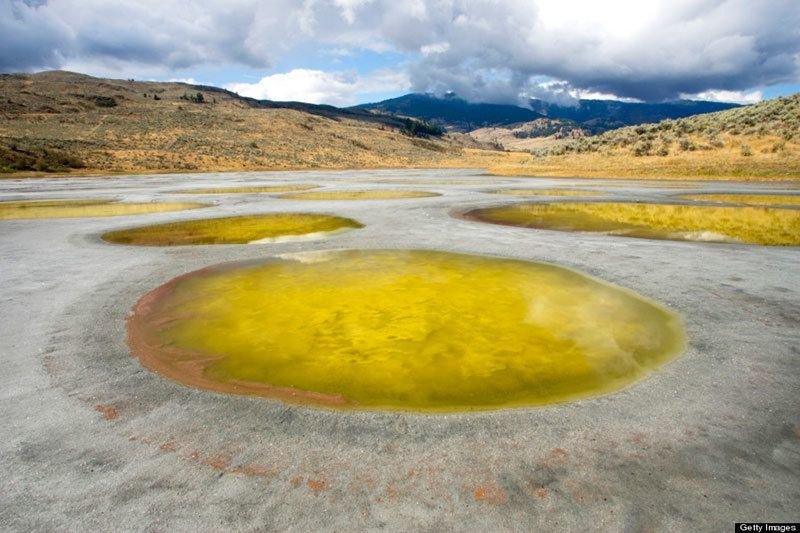
(Image source: all-that-is-interesting.com)
C) A lake?
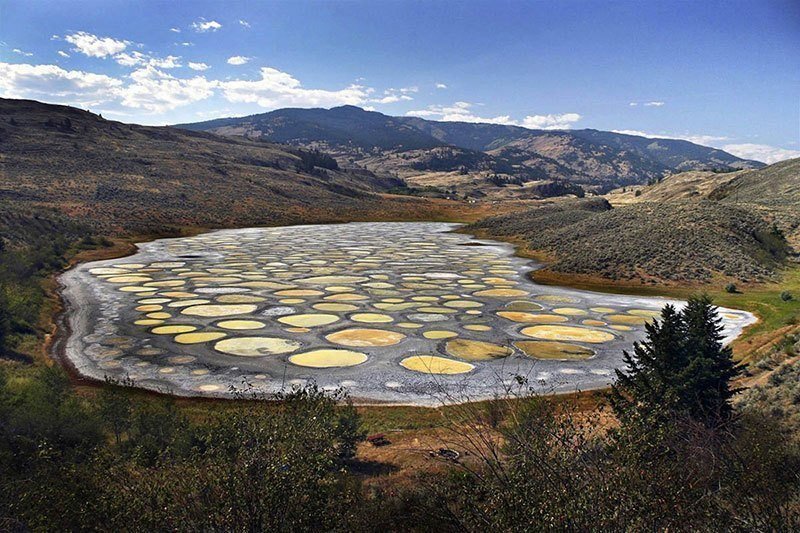
(Image source: all-that-is-interesting.com)
And the answer is... C! A lake, but not a boring, ordinary one like the ones you can go fishing on. Ladies and gentlemen, this is the incredible Lake Kliluk, in the eastern Similkameen Valley, near Osoyoos city (British Columbia, Canada).
This very artistic scenery is the result of highly saline alkali waters. An "art deco" touch by the best decorator ever, mother nature!
The artwork
Kliluk is an endorheic lake (no water flows out through streams or rivers) that "feeds" on rainfall, groundwater, and melting snow. It's almost 0.43 miles (0.7 kilometers) long and 0.16 miles (0.25 kilometers) wide. Rich in minerals, the lake contains large amounts of magnesium sulfate (MgSO4), calcium (Ca), sodium sulfates (Na2SO4) and eight other minerals. There are also lower amounts of silver (Ag) and titanium (Ti).
Nature gets its inspiration during the dry months of summer and creates these unique patterns on the lake's surface, adorning it with various shades of yellow, green and blue. But let's follow the process...
As the only way out of the lake is through evaporation, water has to wait for the summer to escape. When temperatures rise, water says goodbye to the lake leaving behind high concentrations of solid minerals. The souvenir the lake gets to keep are those beautiful "rock" pools and hardened minerals pathways over the surface. The remaining water's color depends on the minerals' concentration within it. In autumn, those formations will start being covered again until the next summer (as if nature clears up her canvas to work on a new project).
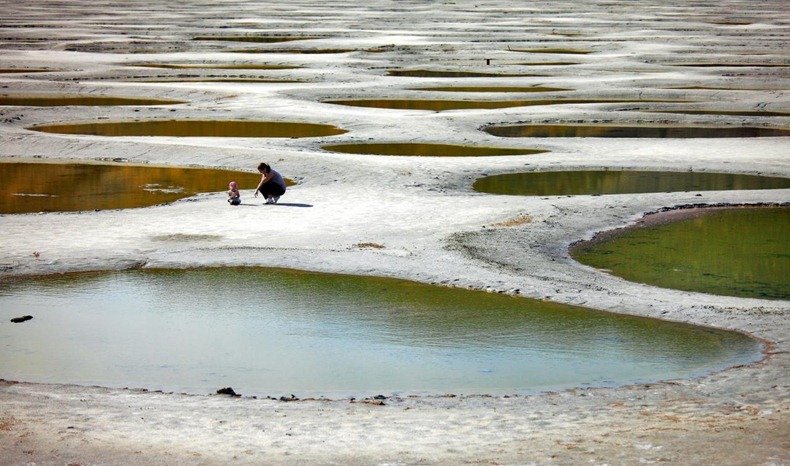
(Image source: amusingplanet.com)
Some history catch-up
The First Nations people of the Osoyoos area respected the lake and considered it a sacred, healing place. They believed that each pool had its own medicinal value, a belief that is actually true, because these waters are a natural remedy for conditions like rheumatoid arthritis. Native tribes of the area took advantage of this natural "chemist's" and used the mud and water for different aches and ailments.
During World War I, the lake was exploited by the ammunition industry. Minerals were extracted and shipped to Eastern Canadian munition factories to be used as raw materials. Before this "looting", the lake was said to display an even greater variety of colors, but war (like another "Gone with the wind" Rhet Butler) does not a give a damn.
The area then was in for greater exploitation under the Ernest Smith family that owned it for about 40 years and planned to set up a spa in 1979. The First Nations did not let that happen and in October 2001 attempted to buy it back. Finally, in collaboration with the Indian Affairs Department, successfully took the land under their protection.
A tourist attraction?
Although a walk around the mineral pools would be fascinating, entrance is not allowed as the the area has been fenced to keep people out. A roadside sign informs travelers that the lake is a cultural and ecologically sensitive area and a traditional medicine lake for the Okanagan (Syilx) people. You can get a good view of it though from the Highway #3 that passes by it, you just have to get in your car and drive to the northwest part of Osoyoos in the eastern Similkameen Valley.
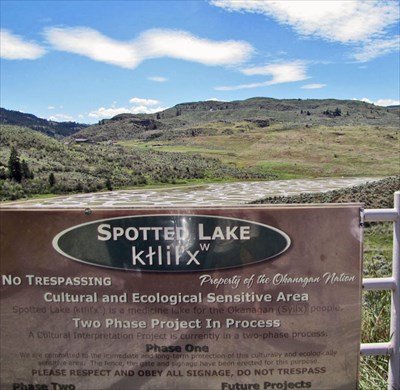
(Image source: waymarking.com)
Scientific interest
Kevin Cannon (Ph.D. in Earth, Environmental and Planetary Sciences at Brown University, Providence, RI - 2017), was allowed to study the lake in 2012. His research was on the mineral composition of Lake Kliluk. Underneath the salty rims of the mineral pools lies a thick, black, rich-in-sulfur and bad-smelling mud, which he studied thoroughly. Some of these pools are also found to be inhabited by a special, salt-loving algae (our journey to the extremophiles' world shall never end on this series).
Inspired by the resemblance of the mineral deposits observed at Colombus crater on Mars, Cannon wanted to study the lake with the hope of reaching a safe conclusion about the climate on the Red Planet. Although his theories cannot be taken for granted as long as the martian environment and life is concerned, it is truly remarkable how outlandish the scenery of the lake is.
Here you can help yourselves to a short video of the lake!
References
lakescientist.com
amusingplanet.com
wikipedia.org
www.nytimes.com
blog.hellobc.com
all-that-is-interesting.com

Thank you for reading today's post! I hope it got you excited enough to follow me, @ruth-girl, for more fascinating phenomena!
If nature's weirdness is your thing, you can check some of the previous articles of this series:
8 - Ice Fumaroles
9 - Blood Falls
10 - The Lava Lake
11 - The Toxic Underwater Lake
12 - Underwater Crop Circles
13 - The Spotted Lake
14 - The Crystal Cave
Interested in science? Please, don't forget to check the @steemstem project, a community-driven project meant to promote well-written, high-quality, STEM-related content (STEM as for Science, Technology, Engineering and Mathematics). Join them in steemit.chat for more information.
And for those engaging with education, @steemiteducation is here to join all steemian educators in their common cause of making our job easier, more effective and more fun!
Finally, the greek community of steemit is here and waiting for you to discover it! Follow the @greek-trail for daily doses of good-quality posts by wonderful writers!
Until my next post,
Steem on, people, and keep smiling!


